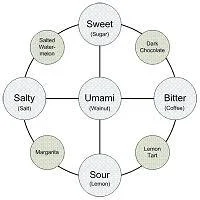This recipe comes from my former Exec Chef at GGM, Brian Roland. It captures all that is healthy, fresh and quintessential Floridian Cuisine.
1 cup O.J.
1/4 cup Lime Juice
1/4 cup Lemon Juice
1 Bunch Scallions, chopped
2 Tbl Garlic, chopped
1/2 Cup Mirin
4 Tbl Miso
1 Tbl Brown Sugar
Method:
Sweat Garlic and Scallions. Deglaze with all 3 citrus juices and reduce for 30 seconds. Add mirin, brown sugar, and miso. Bring to a boil again and lower to a simmer. Cook for 5 minutes on low to incorporate flavors. Reduce lightly to achieve a glaze consistency. Strain when finished.
 Goat Cheese Dumplings
Goat Cheese DumplingsIngredients
8 oz Goat Cheese, Fresh
8 oz Cream Cheese
12 Gyoza Skins (or wonton skins)
1 egg
1 cup cornstarch
Method
Whip the goat cheese and cream cheese together until fully incorporated and smooth. Place in a pastry bag. Crack the egg on a small bowl and mix with a little water to create an egg wash. Lay out the Gyoza skins flat and brush with the egg wash. Pipe the goat cheese/cream cheese mixture into the center, and fold over one side to create a half moon shape. Crimp the edges and dredge the dumplings in corn starch until ready to use, to prevent them from sticking and drying out.
Florida Orange Broth
Ingredients
12 Fresh Florida Oranges
Method
Squeeze the oranges into a bowl. Strain the liquid very well through a strainer with cheese cloth if you have, and serve at room temperature.
Final Plating
 Ingredients
IngredientsGoat Cheese Dumplings
Apple Smoked Bacon
Baby Broccolini
Florida Orange Broth
4 Filets of Chilean Seabass
4 oz Orange Miso Glaze
12 pcs Baby Broccolini, trimmed and blanched
12 Goat Cheese Dumplings
12 oz Florida Orange Broth
4 T Apple Smoked Bacon, Crisped
Method
Sear the seabass filets on high heat in a saute pan with 1T of oil, until the tops have browned. Turn over and brush the tops with the orange miso glaze. Finish in the oven for about 8 -10 minutes. Place the dumplings in boiling water to poach, remove with a slotted spoon when ready. In a saute pan add apple smoked bacon and broccolini, and heat until both are hot. Add the goat cheese dumplings, and continue to heat. Place this mixture in the bottom of a shallow bowl and place the glazed seabass on top. Pour the Florida Orange broth around the bowl and serve.
Bon Appetit!







